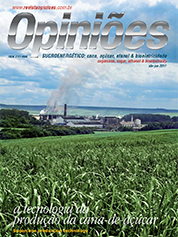Luiz Carlos Dalben
President of Agrícola Rio Claro
Op-AA-28
Sugarcane straw as biomass in the generation of energy
The growing demand for energy in various activities of society is well-known, as is the concern about using clean energy in lieu of pollution-generating sources such as coal, oil and others. In this development, sugarcane again appears as a good alternative, given that with growth in areas planted with sugarcane and the favorable location of sugarcane plantations in relation to large energy consumption centers, along with other factors, it acts as a catalyst of the process, so that one can clearly view the sugarcane crop as a feasible alternative.
With environmental legislation preventing the burning of straw resulting from the sugarcane harvesting and the intensive use of harvesters, one ends up having a large volume of raw material that needs to be better studied and used in the best way possible, both in plantation management and as a source of energy.
Nowadays, following the harvest of green sugarcane using a harvester, a volume of 12 to 15 tons of straw per hectare is left over, which varies according to the time of cutting, the plantation’s development phase, sugarcane variety, etc. This activity results in regional advantages and disadvantages depending on the time of harvesting.
For example, ratoons shoot with more difficulty in places with lower temperatures in the months of May, June, July and mid August, in regions of the states of São Paulo, Paraná and Mato Grosso do Sul, with reductions in productivity due to the delay in germination. During this period, one observes soil temperature differences of up to 15ºC in areas with and without straw, during the first four hours of the day.
Pests such as the spittlebug appear more frequently, difficulties occur in plantations, with the possibility of ratoons catching fire, and other factors, all of which resulted in new techniques. Traffic on plantations, as a result of how straw is handled, is a negative aspect that needs to be watched. One can state that there are advantages in leaving some of the straw behind on the ground, as a means to change soil biology and chemistry, to better preserve humidity, in terms of changes in how pesticides are used, etc.
Seeking viable alternatives both in agriculture, with revenues resulting from this new product, and in industry, in the last five harvests we partnered with Zilor, making use of some of the straw mixed with sugarcane bagasse, in a pioneer energy generation project. This process takes place 7 to 10 days after harvesting by windrowing, when straw humidity is close to 13%. Normally, 60 to 70% of the volume per hectare is collected, allowing for gains due to humidity in the soil and less mineral impurities in the bales.
After windrowing, baling equipment straps the material in round or square bales, the square bales being more advantageous because operational productivity is higher. The square bales weigh 400 kg, compared with 120 to 160 kg of round ones. Furthermore, square bales are pressed, whereas round ones are strapped.
Round bales are more difficult to unstrap for grinding, and there is a loss of load density during transportation due to the accommodation that takes place on trucks and trailers. I believe the collecting system using bales, along with grinding, and with bagasse being added in the mills, is currently more feasible. We are handling low humidity material, raw material with more than 3,200 kg cal/kg, as compared with bagasse that has 50% humidity at 1,800 kg cal/kg.
In the 2010 harvest, Agrícola Rio Claro collected 12,300 tons, using a 70 HP tractor for part time windrowing, baling in round bales, three 75 to 90 HP tractors, or one tractor of 140 or more HP for baling equipment producing square bales, a sugarcane loader and a truck with four trailers. Selling straw has made it possible to achieve a profit at the end of the activity, for the producer and mainly for the industrial unit, through energy generation.
We are also assessing other products to use straw “in natura”, for instance, as briquettes and pellets. Low humidity naturally achieved in the field, makes artificial drying unnecessary, adding costs to other materials, such as wood and others. The difficulty lies in grinding and we are still looking for the best alternative, either to extrude or press, using the selected method. It is quite “easy” to believe there is a good market and high revenues because the product can easily be used in boilers, burners and furnaces.




